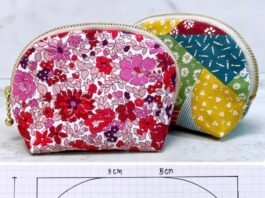Learning how to sew a cell phone bag- Step by Step Tutorial is one of the most rewarding and practical sewing projects you can try. A handmade cell phone bag is not only a functional accessory but also a personal piece of creativity that reflects your style. Whether you are a beginner or someone who has experience with fabric and thread, this tutorial will walk you through every detail to make your project a success. The best part is that once you master the steps, you can personalize the bag in endless ways—choosing different fabrics, patterns, and embellishments.
Many people often buy ready-made phone bags, but making your own allows you to customize size, style, and design according to your needs. With this step by step tutorial, you can ensure that your cell phone bag fits your device perfectly, while also adding pockets or compartments for essentials like cards or keys. The satisfaction of creating something useful with your own hands is truly unmatched. Plus, sewing is an activity that helps reduce stress, improves focus, and nurtures creativity.
By following the how to sew a cell phone bag- Step by Step Tutorial, you will not only end up with a beautiful bag but also gain valuable sewing skills that can be applied to other projects. This guide is written in a simple and humanized way, so you can feel confident as you move from one step to the next. Whether you’re sewing for yourself, as a gift, or even considering selling your handmade bags, this project is both practical and enjoyable.

Choosing the Right Materials
The first important step in this step by step tutorial is choosing the correct materials. Fabric plays the biggest role in the overall look of your bag. Cotton fabric is often the most recommended for beginners because it is easy to handle and widely available. However, you may also try denim, canvas, or linen for more durability. Choosing a lining fabric is equally important as it provides strength and a neat finish inside the bag.
The second material you need to consider is interfacing. Interfacing adds structure to your cell phone bag, preventing it from collapsing or feeling flimsy. There are fusible interfacings that can be ironed onto the fabric, making the process quick and easy. For a stiffer bag, you might want to use heavier interfacing, while lighter interfacing works well for a softer finish.
Don’t forget about the closure mechanism. You may use magnetic snaps, zippers, or even buttons, depending on your design. Each closure option gives your cell phone bag a unique personality. For instance, zippers provide security, while magnetic snaps are stylish and quick to open.
Thread selection is also important. Always choose a high-quality thread that matches your fabric. Strong thread prevents wear and tear, ensuring that your cell phone bag lasts longer. If you’re feeling creative, you can use contrasting thread to add decorative stitching that stands out.
Besides these main materials, you will need basic sewing supplies such as scissors, pins, a ruler, and of course, a sewing machine. If you don’t have a sewing machine, this project can still be done by hand, though it will take longer. Hand-stitching requires patience but provides a rustic and charming look.
By carefully selecting your materials, you set a strong foundation for the entire project. A well-chosen combination of fabric, interfacing, closures, and thread ensures that your cell phone bag will be both stylish and durable.
Cutting and Preparing the Fabric
Once your materials are ready, the next part of this how to sew a cell phone bag- Step by Step Tutorial is cutting the fabric pieces. Start by measuring your phone accurately. You need to allow extra space for seams, so add at least one inch on each side of your measurements. This ensures your phone slides in comfortably without being too tight.
After taking measurements, use a ruler and fabric chalk to mark the dimensions on your chosen fabric. You will need two main outer fabric pieces, two lining pieces, and interfacing cut to the same size. If you’re adding a pocket, cut an additional smaller piece that will fit comfortably on the front or inside of the bag.
Once the fabric is marked, carefully cut along the lines using fabric scissors. Make sure to cut as neatly as possible because uneven edges can affect the final look of your bag. For beginners, taking time during this stage is crucial since accurate cuts make sewing much easier.
Next, iron your fabric and interfacing. Pressing the pieces ensures they are flat and smooth, making them easier to work with. If you are using fusible interfacing, now is the time to attach it to the wrong side of your outer fabric. The added stiffness will make sewing much more manageable.
At this stage, it’s also a good idea to pin or clip your pieces together for a test layout. Place the lining inside the outer fabric, aligning edges to ensure everything fits properly. This quick test prevents mistakes later and gives you a visual preview of your cell phone bag.
Proper preparation makes the sewing process smoother and reduces the risk of errors. Cutting and ironing may seem like small steps, but they truly set the foundation for a professional-looking bag.
Sewing the Cell Phone Bag
Now comes the most exciting part of this step by step tutorial: sewing the cell phone bag. Begin by attaching the pocket, if you have decided to include one. Place it on the front piece of your outer fabric and stitch along the sides and bottom, leaving the top open. This creates a useful space for cards, earbuds, or small items.
Next, sew the outer fabric pieces together. Place them right sides facing each other and stitch along the sides and bottom, leaving the top open. Do the same with the lining pieces. Make sure your seam allowances are consistent, usually around ¼ inch. This keeps everything neat and proportional.
If you’re using a zipper, attach it before combining the lining with the outer fabric. Place the zipper face down on the edge of the fabric and stitch it in place, then repeat with the lining. If you prefer a magnetic snap, attach it at this stage, following the instructions that come with the snap.
Once closures are in place, insert the lining inside the outer fabric with right sides facing each other. Align the edges and stitch around the top edge of the bag. Remember to leave a small opening so you can turn the bag right side out later.
After stitching, carefully turn the bag right side out through the opening. Push out the corners gently with a blunt tool, such as a pencil, to make them crisp. Press the bag with an iron to smooth out any wrinkles. Then, sew the opening closed with a small invisible stitch or by topstitching around the edge.
At this point, your cell phone bag is complete. You can add decorative details like embroidery, appliqués, or even fabric paint to personalize it further. The possibilities are endless once you master this technique.
Tips for Customization and Creativity
This how to sew a cell phone bag- Step by Step Tutorial also gives you freedom to experiment with creativity. Adding embellishments is one of the best ways to make your bag unique. For example, you can stitch lace along the edge, use colorful buttons, or even add fabric flowers. These small touches can transform a simple bag into a standout accessory.
You can also experiment with fabric combinations. Using contrasting fabrics for the lining and outer layer creates a fun surprise when you open the bag. Patchwork designs are another option, allowing you to use leftover fabric scraps in a stylish way.
Another creative idea is adjusting the strap. You may sew a short wrist strap, a long crossbody strap, or even use a detachable chain. Each strap option gives your cell phone bag a different style, whether casual, elegant, or practical.
Adding compartments is another way to personalize your project. By sewing dividers inside the bag, you can create separate spaces for cards, money, or earphones. This makes your handmade cell phone bag not only beautiful but also highly functional.
If you enjoy embroidery or hand-stitching, consider adding decorative stitches along the edges. This detail highlights your craftsmanship and gives the bag a unique personality. Contrasting thread colors can create eye-catching borders that stand out against the main fabric.
Finally, think about seasonal designs. You can make themed bags for different occasions such as Christmas, Valentine’s Day, or summer holidays. This keeps the project exciting and ensures that you always have a stylish accessory to match the season.
FAQ – How to sew a cell phone bag- Step by Step Tutorial
1. Can I sew a cell phone bag without a sewing machine?
Yes, you can hand sew a cell phone bag using a strong backstitch. It will take longer, but the result can be just as sturdy and charming.
2. What type of fabric is best for beginners?
Cotton is highly recommended because it is easy to cut and sew. It is also widely available and comes in many colors and patterns.
3. How do I make sure the bag fits my phone perfectly?
Measure your phone and add at least one inch to the width and height for seam allowance. Always test fit before final stitching.
4. Can I add a strap to my cell phone bag?
Absolutely! You can add short or long straps depending on your preference. A detachable strap is also a great option for versatility.
5. How do I make my bag more durable?
Use interfacing for structure, strong thread, and high-quality fabric. Reinforcing the seams with double stitching also adds strength.
6. Can I wash my handmade cell phone bag?
Yes, but it depends on the fabric. Cotton bags can usually be machine washed on a gentle cycle, while delicate fabrics may require hand washing.
7. What is the easiest closure for beginners?
Magnetic snaps are very beginner-friendly since they require minimal sewing. Velcro is another simple and effective option.
8. Can I sell the cell phone bags I make?
Yes, many people sell handmade phone bags as part of a small business. Just be sure your bags are neatly sewn and durable for customer satisfaction.
9. How long does it take to make one bag?
On average, it takes about 1–2 hours for beginners and less than an hour for experienced sewers.
10. Do I need a pattern for this project?
Not necessarily. Since cell phones come in different sizes, making your own measurements is often better than following a universal pattern.
Conclusion
In this how to sew a cell phone bag- Step by Step Tutorial, we covered everything from selecting materials and cutting fabric to sewing and adding creative customizations. With patience and creativity, anyone can make a practical and stylish accessory that protects their phone while showing off their personal style.
Sewing your own bag not only saves money but also gives you the freedom to design something truly unique.
Now that you’ve learned this simple yet rewarding project, I’d love to hear from you. Share your thoughts, experiences, and suggestions in the comments. Did you enjoy this tutorial? What kind of design would you like to try for your own cell phone bag? Your feedback will help improve future tutorials and inspire other sewing enthusiasts.





